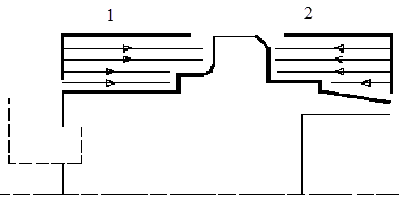Strategy Parameters | ||
| ||
![]()
Strategy Parameters
- Tool Axis
The Tool Axis command in the Turning Operations dialog box is represented by an arrow when creating a part operation.
See Defining the Tool Axis
- Max Depth of Cut
- Specifies the maximum distance between passes.
- Roughing Strategy:
- Specifies roughing strategy as:
- Longitudinal
- Face
- Orientation
- The selected orientation defines the type of geometric relimitation to
be done between the rough stock and part geometry in
order to determine the area to machine.
You can specify:
- External, Internal for Longitudinal recessing strategy.
- External, Internal, or Frontal for Face recessing strategy.

1 is Part Profile
2 is rough stock Profile

1 is Part Profile
2 is rough stock Profile
In Frontal orientation, the minimum and maximum diameters of the area to machine are determined by the rough stock profile dimensions.
For example, in the following figure the area to machine is relimited by the spindle axis because the rough stock profile is also relimited by the spindle axis.

1 is Part Profile
2 is rough stock Profile
- Location
- Specifies location.
It determine the way the program closes the area to machining. The following machining location types are proposed:
- Front: the part is machined toward the head rough stock
- Back: the part is machined from the head rough stock

- Machining Direction
- Specifies the machining direction with respect to the spindle axis. You
can specify Machining Direction only for
Face roughing with
Frontal orientation. The choices are:
- To Spindle
- From Spindle
- Under Spindle Axis Machining
- Select this check box to request machining under the spindle axis, for Face roughing strategy
- Tool Compensation
- Select a tool compensation number corresponding
to the desired tool output point.
The usable compensation numbers are defined on the tool assembly linked to the Machining Operation.
By default, the output point corresponding to type P9 is used, if you do not select a tool compensation number.
Options
- Entry Flank Angle
- Specifies the entry flank angle.
The insert geometry is taken into account to avoid collision by reducing the maximum slope on which machining is done. Defining an Entry Flank Angle on the Machining Operation allows you to further reduce the area to machine.
- Clearance
- Specifies values on the check element for the first and
second cuts.
A leading angle can also be defined on the insert-holder to define the maximum slope on which machining is done. In this case and if the Insert-Holder Constraints setting is applied, the angle that reduces the slope most is taken into account.
- Insert-Holder Constraints
- Specifies insert-holder constraints as:
- Ignore
- Apply
The following attributes (located on the Insert-holder's Technology tab) may influence machining: See Creating and Editing Milling, Drilling, and Probing Tools:
- Trailing angle
- Leading angle
- Maximum recessing depth
- Maximum boring depth
These attributes take tooling accessibility into account and may reduce the machined area.
However, you can use the Insert-Holder Constraints option to either ignore or apply these tooling attributes. You can replay the operation to verify the influence of these attributes on the generated tool path.
The Insert-Holder Constraints setting does not influence the Entry Flank Angle.
- Minimum Machining Radius
- Specifies the minimum machining radius.
This option is available when Orientation is External.

- Leading Angle (Defined on Tool)
- Minimum Machining Radius
- Part Profile
- Leading Angle
- Spindle Axis
- Maximum Machining Radius
- Specifies the maximum internal machining radius.
This option is available when Machining Direction is From Spindle.
Note: Maximum boring depth is defined on the tool. - Axial Limit for Chuck Jaws
- Specifies the axial limits. Offset defined from the machining axis system.

- Maximum Machining Radius
- Spindle Axis
- Max Boring Depth
- Machining Tolerance
- Specifies the maximum allowed distance between the theoretical and computed tool path.
Rework Parameters
- Lift-off Distance and Lift-off Angle
- Specifies Lift-off Distance and
Lift-off Angle.
These parameters define the lift-off vector at the end of each pass with respect to the cutting direction.
- Lead-in Distance
- Specifies Lead-in Distance with respect to the cutting direction. It takes the rough stock profile and rough stock clearance into account. The tool is in RAPID mode before this distance.
- Start pass mode
- Specifies the pass mode. This is defined by one of the following
settings:
- Chamfer
- Rounded
- None
- Rework Mode
- Select this check box to make the following options are available:
- Distance before Rework Plunge
- Angle before Rework Plunge